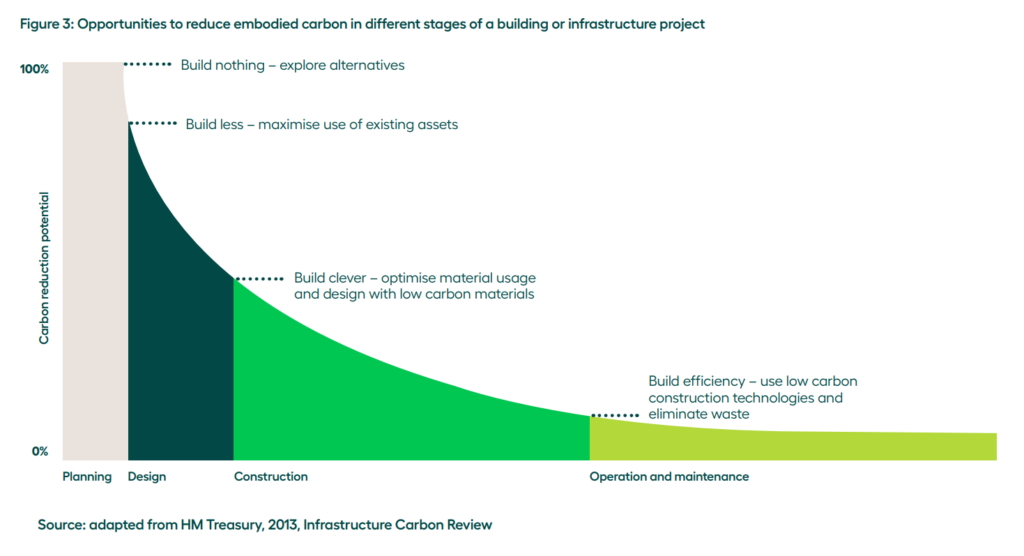In Australia, we have a real opportunity to reduce carbon emissions generated from the construction industry as a direct result of our growing infrastructure. The journey to net-zero was recently made a little easier with The Clean Energy Finance Corp (CEFC), who invests commercially to increase the flow of funds into renewable energy, energy efficiency and low emissions technologies.
‘The CEFC has a unique mission to accelerate investment in Australia’s transition to net zero emissions. We invest to lead the market, operating with commercial rigour to address some of Australia’s toughest emissions challenges’.
In February 2022, the CEFC released the report ‘Australian building and infrastructure: Opportunities for cutting embodied carbon’ in conjunction with Edge Environment, Green Building Council of Australia (GBCA) and Infrastructure Sustainability Council (ISC).
The report details pragmatic advice and cost analysis on potential opportunities for reducing embodied carbon, aimed at investors and developers to better understand how embodied carbon can contribute to their emissions reduction ambitions.
One major outcome from the report was the Timber Building Program – a $300 million dollar debt finance initiative to encourage mass timber construction across the property sector. This monumental announcement means that the construction industry can better utilise timber to reduce emission targets, creating a positive flow on effect for the entire sector.
We’ve hand-picked the best parts of the report and program in this short blog, so you can get all the information you need if wanting to invest in mass timber.
The CEFC report indicates there is a significant opportunity for improvement when it comes to emissions in construction.
‘Edge Environment estimate the embodied carbon emissions of materials is approximately five to ten percent of national greenhouse gas emissions’.
Throughout the report, carbon emissions are measured in embodied carbon, which is measured by the greenhouse gas emissions (carbon dioxide equivalent) that occur during a material’s resource extraction, manufacturing and transportation to construction site.
Also detailed was the prospect to enact real change during the planning and design stages of a project timeline. This means not only switching to better materials for the environment but specifying materials that also produce a cost saving. The table below extracted from the CEFC report demonstrates the importance of utilising carbon neutral or better materials early on in a project’s development.

In Australia, we have several existing, cost-effective options to reduce carbon emissions. When it comes to design specifically, the report found initiatives for timber, concrete and steel. Timber being highlighted as using engineered timber products (mass timber) instead of steel.
A cost analysis in the report demonstrated that engineered wood products are cost negative for office/mixed use and industrial buildings, meaning they will reduce both the cost and emissions in a project, further summarised in the diagram below (extracted from the CEFC report).

‘Implementing a 30% uptake of the three cost-neutral and cost-negative initiatives [pre-cast concrete, engineered wood products and SCM concrete] has the potential to abate approximately 4,500 tonne CO2-e, a 12% reduction in embodied carbon’.
Based on the report findings, CEFC created initiatives to assist developers and investors in switching to materials that reduce carbon emissions.
CEFC, who invests on behalf of the Australian Government, launched the Timber Building Program. The program allocates $300M in debt finance to encourage mass timber construction across the property sector.
Why mass timber? CEFC analysis suggests the use of mass timber construction methods cut as much as 75 percent in embodied carbon emissions compared with conventional steel and concrete designs.
Eligible projects will be considered on a case-by-case basis in commercial offices, retail, industrial, healthcare and education.
Learn more about the Timber Building Program by reading this CEFC fact sheet here.
The first project to be financed through the specialist CEFC Timber Building Program is T3 Collingwood by Hines, otherwise known as 36 Wellington Street, in Melbourne which ASH has proudly supplied MASSLAM columns and beams. Ten of the 15 levels feature exposed glulam mass timber members, making it the largest mass timber, multi-storey building in Australia.
We now know that mass timber positively contributes towards net-zero objectives, and products like our MASSLAM columns, beams, flooring and roof structures can assist in greener cities nationwide. Once you consider that MASSLAM forms the structure AND the architectural finish, the system also allows you to ‘build less’ by eliminating the need for additional claddings or coverings – further reducing impact. We are entering an exciting time for construction, as we have been given the opportunity with programs like this one to enact real change within our living environment.
Parties who are interested in seeking finance through the program, can find more information in the property section of the CEFC website.
"*" indicates required fields
